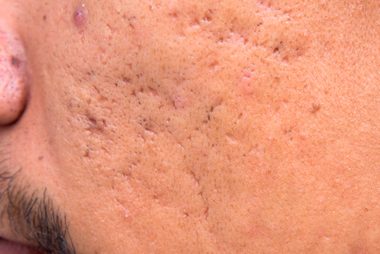
Ice pick scars
As the name suggests, ice pick scars are very deep acne scars that look like the skin has been punctured with… an ice pick. When the body produces too little collagen in response to an injury, depressed scars such as ice picks can form. “Ice pick scars represent the result of infected sebaceous gland openings on the skin. They are usually the most difficult to correct,” says New York City plastic surgeon Gerald Imber, MD.
Acne scar treatment: “Treatment may include excising the scar with a small ‘punch,’ and suturing the defect closed, but this only works for isolated ice pick scars,” he says. New York City dermatologist Judy Hellman, MD, adds: “We can also do skin grafts and take skin from behind the ear to fill the scar, and then we can use a laser or radiofrequency device to smooth it out.”
If there are multiple ice pick scars, acne scar treatment devices that use radiofrequency energy are Dr. Hellman’s first choice. “These treatments help build collagen from the inside out, and collagen helps to fill the scars from within,” she says. Several treatments are usually needed. The procedures are done using local anesthesia, and it’s effective in all skin types, she says. In one study, published in a 2015 issue of the Journal of Cosmetics, Dermatological Sciences and Applications, Dr. Hellman found that approximately four treatments with a radiofrequency device produced significant improvement in the depth of the scars. A follow-up study in a 2016 issue of the same journal showed that these results held for up to two years, although some people had touch-ups.
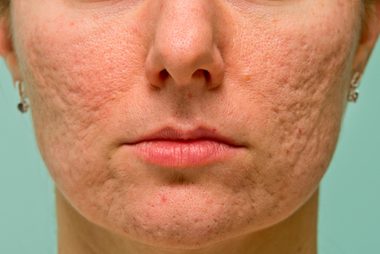
Boxcar scars
Boxcar scars are also depressed, but they tend to be broader and boxier than ice picks. Everyone heals differently, and depressed acne scars like boxcars form when too little collagen is produced during wound healing.
Acne scar treatment: Energy-based skin resurfacing with a laser, radiofrequency, or an ultrasound device can help treat boxcar scars, according to Nada Elbuluk, MD, an assistant professor at the Ronald O. Perelman Department of Dermatology at New York University Langone Medical Center in New York City. “They all work by creating new collagen beneath the surface of the skin.” A series of treatments is likely needed based on the extent of scarring, she says. Chemical peels can also help but to a lesser extent. With either procedure, using a retinoid to increase cell turnover and further boost collagen can help improve results, Dr. Elbuluk adds.
There is also a role for Bellafill and other injectable fillers, including fat, for some depressed scars. Bellafill is currently the only filler that’s approved by the U.S. Food and Drug Administration to help raise depressed scars. It packs a one-two punch by adding volume, and also encouraging collagen formation beneath the surface by creating a supportive scaffold. “Bellafill and other injectables can fill in scars but these tend to be better for one scar,” adds New York City facial plastic surgeon Jennifer Levine, MD. Filler results can last up to 18 months. “If you have a cheek full of depressed scars, it’s better to resurface the face with laser, radiofrequency, or another energy-based treatment,” she adds. Try these DIY face masks to soothe dry skin.
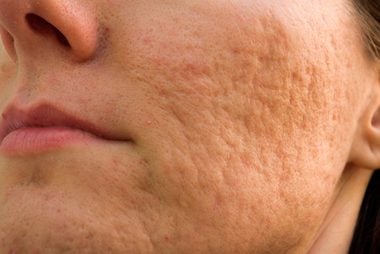
Rolling scars
Rolling scars have smooth edges and look like tiny hills and valleys. These are also considered depressed acne scars.
Acne scar treatment: “Rolling scars can be treated with microfat injections followed by microneedling with platelet-rich plasma (PRP),” says Dr. Imber. Microneedling creates tiny wounds or pinpricks in the skin. The body’s natural, controlled healing process then kicks in to boost internal collagen production. Microneedling is also a great acne scar treatment because it opens up channels within the skin that give PRP—the healing factors in your own blood—and skin care products direct access to deeper layers of the skin where they’re needed most. PRP is created by taking some of your blood, isolating the platelet-rich plasma, which contains proteins and other growth factors, and injecting it back into the scar. “The objective is to build up the collagen layer under the depression in order to raise it to the level of the surrounding skin,” Dr. Imber says. You’ll likely need multiple treatments, but the results are worth it. This approach is backed up by a new study in the January 2017 issue of Aesthetic Plastic Surgery, which found that fat plus PRP improve depressed scars alone and in combination with laser skin resurfacing. What’s more, the treatment improved the social life and relationships of people with scarring, the study showed. Here’s the proper way to use apple cider vinegar for your skin.
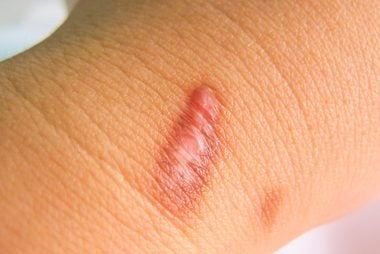
Keloid scars
Keloids are raised scars that can be reddish, especially in lighter skin, says Dr. Elbuluk. In darker skin, they may appear pinkish.
Acne scar treatment: Injections of steroids can flatten keloid scars, according to Dr. Elbuluk. When they are discolored or red, there is some active inflammation in the skin. “The goal is to make the inflammation go away,” she says, “and certain lasers, such as pulsed dye laser, can improve any discoloration by targeting blood vessels.” Cryosurgery freezes the scar tissue, causing it to slough off, but this can cause pigmentation problems of its own among people with darker skin, who are already at higher risk for keloids. Prevention has an important role to play for anyone who is prone to keloids, she says. Using a scar-minimizing treatment like Mederma and/or silicone gel scar sheets before scars form can help stave off a keloid. Vitamin C serums can also reduce pigmentation around a keloid scar.
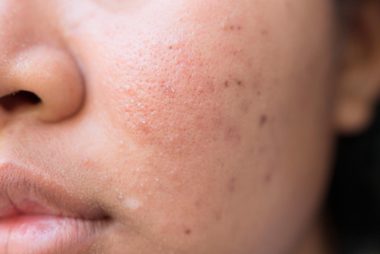
Hyperpigmentation
Hyperpigmentation is a dark spot or discoloration caused by acne-related inflammation.
Acne scar treatment: The best acne scar treatment for hyperpigmentation is with 4 percent hydroquinone and sunblock, according to Dr. Imber. Hydroquinone is a topical bleaching agent that you apply directly to a dark spot. Sunblock is essential, since sun exposure can worsen hyperpigmentation. Other potential treatments include glycolic acid products, which remove the upper-most layer of the skin and the dark marks, and retinoids to increase skin cell turnover, Dr. Elbuluk says. These can be used with the bleaching agent hydroquinone as well. “We can also try glycolic acid chemical peels in the office at higher doses than you could do at home,” she says. “If peels don’t do the trick, lasers are usually the next thing we would try to improve hyperpigmentation.” These six bad beauty habits could be what’s standing in your way to clear skin.
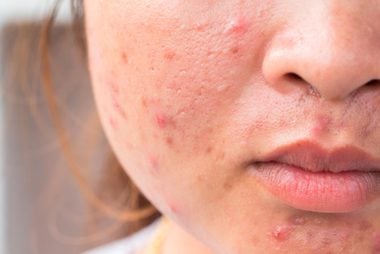
Combination scars
Most people have some combination of acne scars. “You can have some scars that are reddish, others that are pale, and then an ice pick next to a box car,” says Dr. Levine.
Acne scar treatment: “You have to take all of these factors into account, and I always advise people that multiple treatments will be needed, and even after a year or two, a 50 percent improvement may be all they get,” Dr. Levine says. Still, it’s important to remember that less visible or deep scars can still make a difference to a person’s self-esteem. “It takes patience, but every scar can be improved, and even if the results are not perfect,” says Dr. Hellman.
As far as combination scars go, Dr. Levine’s go-to acne scar treatment for combination-type scars include a series of treatments with picosecond lasers such as the Picosure or use of the FRAX 1550* Fractional non-ablative laser. “These are newer technologies, and they have less downtime than older lasers, so for me this means I can be more aggressive and see results with fewer treatments.” Older ablative lasers blast off the skin’s top layers, which requires significant downtime, but these newer non-ablative lasers pass through the skin’s upper layers to harmlessly heat the deeper tissues, stimulating collagen and smoothing the scar’s appearance. Here are some natural face cleansers you can make yourself.
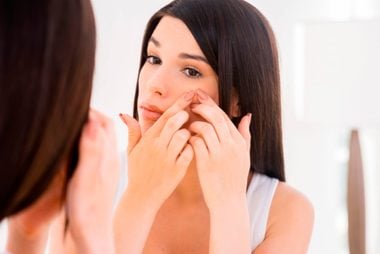
Prevention is key
Some of us are more at risk for acne scars than others, although there is no way to say for sure who will develop scars after acne and who will not. These scars tend to occur more commonly after inflammatory acne, especially when it’s not treated early and aggressively. Other risks include picking squeezing or popping zits. (But whatever you do, never, ever pop a zit in the “danger triangle.”) Genetics can also play a role. “The earlier that acne gets treated, the better,” says Dr. Levine. “If somebody has active acne at 13 or 14, we want to jump on it.” Some scar resurfacing treatments also help keep acne at bay, she says. Dr. Imber adds that Youth Corridor RetinUltimate Transforming Gel applied twice daily can help treat active acne and prevent recurrence. Next, learn about the daily habits of people who never get acne.
